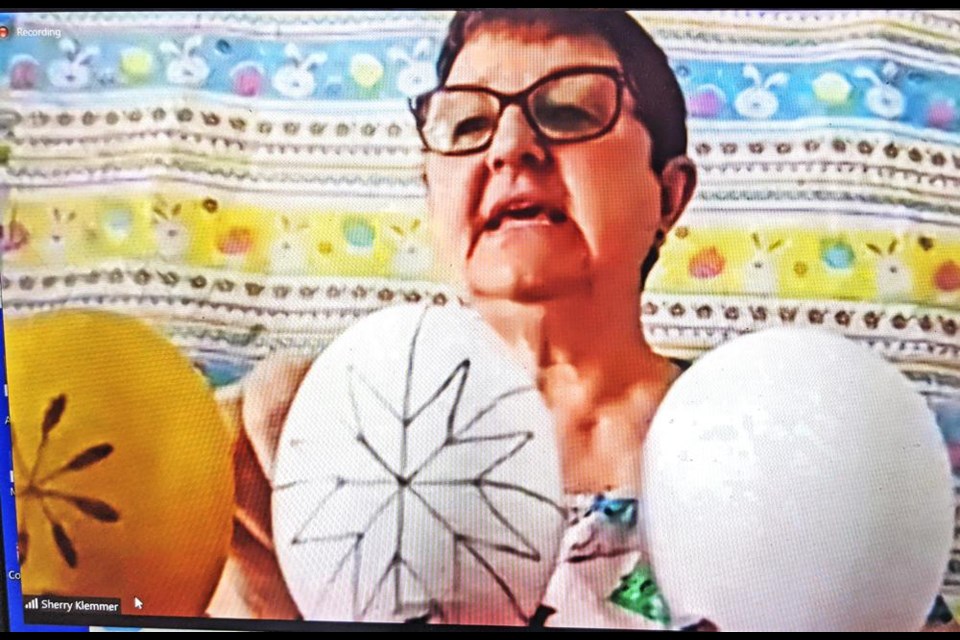WEYBURN – Sherry Klemmer first learned how to decorate Ukrainian Easter eggs when she was nine years old, and she has been painting intricate designs on eggs every year since.
The Weyburn resident shared her passion for Ukrainian Easter eggs, or Pysanka, with the Weyburn Rotary Club on Thursday, doing her presentation via Zoom due to the snowstorm that hit the Weyburn region, keeping everyone at home.
Prior to demonstrating how she does the egg-decorating, she shared how she took part in a huge Zoom gathering of fellow egg artists from all around the world to show support for the people of Ukraine, and described it as “a very emotional experience.”
Among those who took part were many from Ukraine who shared about how they are faring in the midst of the Russian invasion while showing their particular techniques and styles of decorating eggs.
“It was a wonderful experience to see all these people from Ukraine. There were many people talking from Ukraine directly and telling us about the war and how it’s affected them. Despite all of that, it was so heart-warming that these people still have a positive outlook on life. They’re so positive about their futures, people who had stores and people who ran away with nothing, and all these stores sent them egg-making supplies. I just thought, oh my goodness, this is just beyond anything when I think about how I feel and how devastated the people are. It really affected the way I look at things,” said Klemmer.
Klemmer noted the Zoom session went from 9 a.m. to 11 p.m., with people able to drop in at any time to show how they make pysanka, and estimated there were 1,000 people at any given time showing their unique styles of decorating eggs.
Rotary meeting moderator Doug Loden asked her about hearing from people in Ukraine, expressing hopefulness as they shared their art in making pysanka.
“It’s hard to understand how they are hopeful, with the Russian army attacking,” he said.
“I truly was surprised, because I think of ourselves here in Canada, and to see how these people are being trampled, and how they could be so positive. It’s a way of handling it, I think. What else can they do but try to be positive?” said Klemmer.
She noted one lady taking part showed her egg-decorating supplies, and said this was all she had left, all she was able to salvage from her home before leaving it.
“I was in that Zoom call having 1,000 people all doing their eggs at the same time. It’s a relaxing experience – that’s what I feel when I’m doing it. I’m in my own world, and this was what the people were experiencing, getting their minds off everything,” said Klemmer.
She first learned about pysanka when she attended a Ukrainian Orthodox camp in Canora at the age of nine, “and I’ve been making them every year since then.”
There is a lot of symbolism in the shapes and colours used on the eggs, explained Klemmer.
For example, triangles symbolize the Trinity, and a series of 40 triangles denotes the 40 days and 40 nights Jesus spent in the desert during His ministry. Ribbons, belts or lines that encircle the egg symbolizes eternity; an eight-pointed star denotes the sun; a tree denotes the Tree of Life; a hen is a symbol of fertility; a deer denotes wealth; and plants and animals are often used.
Colours carry many different meanings, she added. White denotes purity, innocence and birth; red, passion, happiness and hope; yellow means light, purity, youth and hospitality; green means new growth and hope; black means remembrance; and blue denotes the sky with its life-giving air.
She also noted different regions of Ukraine will use different types of designs and colours, and one could pick out what part of Ukraine an egg came from.
In demonstrating how she decorates an egg, Klemmer said it’s best to start with a white farm egg, noting that store-bought eggs have been washed with chemicals, and the wax will not adhere to the egg as a result.
Also when handling the eggs, she said tissues are useful to prevent oils from one’s hand getting on the eggs. The oils will prevent the colour dye from taking.
To draw a design on an egg, Klemmer said a person could use either a manual kistka, which is a hot wax pen, or an electric one as she does, which will provide a steady flow of wax that doesn’t need reheating as a manual one does.
The egg is then dipped in dye, starting with yellow then gradually moving to reds and darker colours, with the final colour being black.
The second last step, which Klemmer said she enjoys the most, is using a candle to melt off the wax, which is wiped away to reveal the artistry of the designs underneath.
Once the egg is done, the egg is varnished with a urethane varnish which makes the design and colours permanent on the egg.






